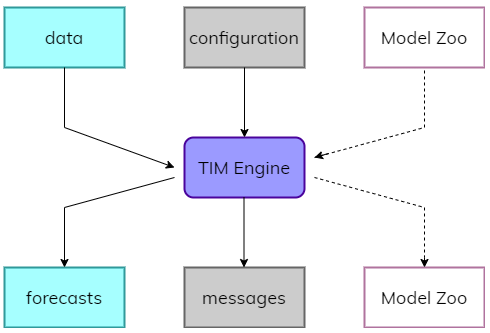Structure
This section provides an overview of the structure of the forecasting tasks that TIM executes, the expected inputs, and the outputs that will be calculated.
The image below shows the TIM Forecasting process.

To create a forecast, TIM requires the following inputs:
Data: historical data used to build the model(s) and to make the forecast(s).
Configuration: mathematical settings and other relevant parameters. All configuration settings are optional.
Model Zoo: previously built models. The Model Zoo has to be included when using the rebuild-model, predict or rca method. It is not an input of a build-model job. The Model Zoo, as an input, is always a part of a parent job.
The TIM engine processes these inputs during the model building or prediction phase. TIM returns the following :
Model Zoo: a new Model Zoo (build-model) or an updated Model Zoo (merge of the input Model Zoo and the newly built and/or updated models; rebuild-model). The predict and rca methods do not return a Model Zoo.
Forecasts: a tabular output encapsulating all backtesting and production forecasts, as well as insights into the model(s).
Messages: errors, warnings and other instructive messages about your data or the forecasting process.